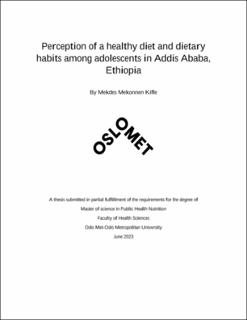| dc.description.abstract | Abstract
Background: A healthy diet is critical for appropriate child and adolescent health and development as well as for preventing the development of diseases, particularly non-communicable diseases. In low- and middle-income countries, there is an increasing challenge of a double burden of malnutrition. In Ethiopia adolescent undernutrition remains a significant public health problem. While the prevalence of overweight and obesity among children and adolescents is not yet excessively high but is an emerging nutrition-related problem.
Objective: To explore the perception of a healthy diet and dietary habits among adolescents in Addis Ababa, Ethiopia.
Method and target group: The study has a qualitative research design. It was conducted in two governmental and two private schools located in Addis Ababa, Ethiopia. It involved 12 focus group discussions with a total of 51 participants, comprising 38 students and 13 teachers. The focus group interviews were transcribed using F4 transcript, and thematic analysis was used as a method of analysis. The factors affecting adolescents' dietary habits were categorized based on the Socioecological Model.
Result: Adolescents perceived a healthy diet as a balanced diet, with fruits, vegetables, and homemade foods being considered examples of healthy foods. Factors affecting adolescents' dietary habits include self-image, disease, nutritional knowledge, time constraints, and personal preferences at the individual level. At the interpersonal level, family, friends, healthcare professionals, and individuals who are fit or obese were identified. At the organizational level, factors such as availability, accessibility, food safety, advertisements, and educational systems were mentioned. At the community level, community attitudes were stated, as well as a lack of birth limits. At the macro level, the increased cost of living, changes in food production methods, and political instability were identified.
Conclusion: To promote healthy dietary choices among adolescents, it is important to raise awareness by integrating nutrition into the education curriculum, implementing school feeding programs, and establishing rules and regulations on dietary advertising and marketing to create a healthy school food environment. | en_US |
